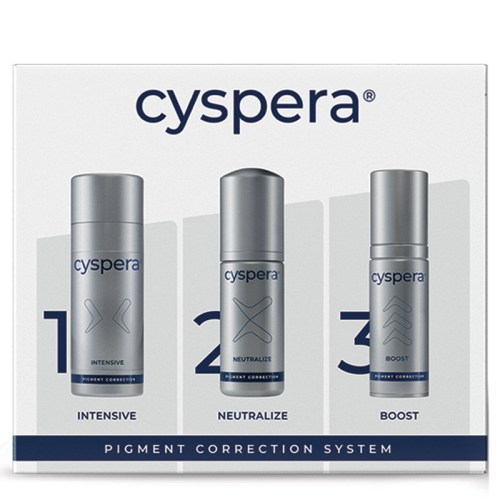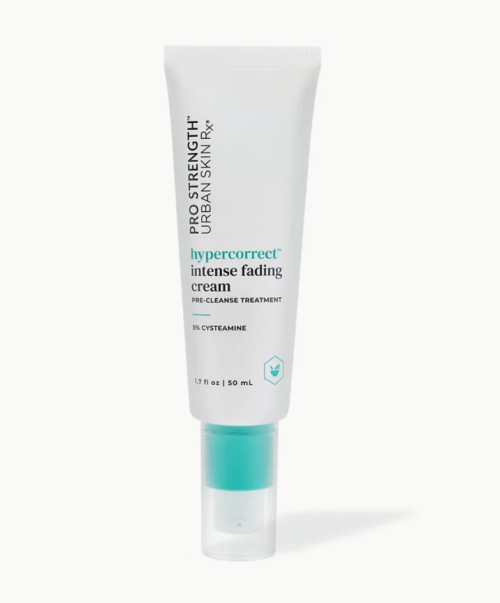Our editors independently select these products. Making a purchase through our links may earn Well+Good a commission
Skin of color is prone to hyperpigmentation, a type of discoloration that can be caused by UV exposure, changes in hormone levels, and inflammation. It’s notoriously hard to treat, and for decades, hydroquinone was pretty much the only option for dealing with it.
Experts in This Article
Mikki Bey Crawford is the U.S. vice president of Swiss-based skin-care brand Cyspera.
Rachel Roff is an esthetician and founder of Urban Skin Rx.
But after over-the-counter sales of the controversial skin-lightening ingredient were banned in 2020 as part of the CARES Act, a superior active has stepped up to take its place as the go-to for fighting dark spots. Enter: cysteamine, which you’re about to see a whole lot more of.
What is cysteamine
Cysteamine, an amino-acid derivative present in all human tissue, works by reducing of cysteine (another naturally-occurring amino acid) in your body.
When you have too much cysteine, it can cause increased melanin synthesis, which leads to hyperpigmentation. It also leads to kidney and eye issues, and initially, cysteamine was being studied as a remedy for these concerns—but then it found its way into pigment research.
“Its [discoloration-reducing abilities] were discovered when scientists were studying it and working with goldfish, and noticed that the black goldfish turned white,” says Mikki Bey Crawford, U.S. vice president of Swiss-based skin-care brand Cyspera. Now, she adds, “It’s widely known in the medical field for its role in pigment reduction while working like an antioxidant to protect against free radicals.”
Applied topically, cysteamine lightens the skin—but it isn’t a skin-bleaching ingredient. When used in low concentrations, it simply works to return your skin to its baseline shade, and has been proven to be more effective than hydroquinone for getting the job done.
“Whenever you are using an ingredient that exfoliates or reduces melanin synthesis, you can watch your skin tone get lighter,” says Rachel Roff, esthetician and founder of skin-care line Urban Skin Rx. “But I always tell people, as long as it’s not going lighter than your boobs or your butt—those areas that don’t see the sun—it’s not bleaching you, it’s just returning your skin tone to its complexion before it’s had years of sun damage.”
How to use cysteamine
To use cysteamine topically, apply it to dry, unwashed skin once daily and let it sit for 15 minutes before washing it off with a gentle cleanser. You can use it in the morning (after you wake up but before you wash your face) or at night (again, before you wash your face). If you’re using it as a part of your p.m. routine, it may feel completely bizarre to apply a treatment product on top of whatever makeup/grime/sweat/sunscreen accumulated on your face during the day, but Roff says that’s totally okay. Regardless of what time of day you apply it, it may tingle a little bit, which is normal.
As with any new ingredient you’re adding to your regimen, you’ll want to be careful about mixing cysteamine with other actives—especially if you have sensitive skin. “In the first week or two, just follow it with a moisturizer and sunblock. After that first week or two, you can introduce your vitamin C serum or let’s say a light AHA toner,” says Roff. If your skin doesn’t feel irritated or excessively dry after another two weeks, you can start back up with your other corrective treatments, like retinol and glycolic acid.
If you’re on any prescription treatments, chat with your dermatologist before trying cysteamine. “I probably wouldn’t use this with tretinoin or hydroquinone,” says Roff. She adds that if you’re on hydroquinone from your dermatologist, there’s no need to use cysteamine, too.
The one downside of the ingredient: it stinks. The smell is “a cross between sulfur and maybe hair perm,” says Roff. Her description of the smell is spot on, but luckily, “it washes off when you wash your face off,” she says. In the few cysteamine formulas I’ve tested, I’ve noticed the scent is super strong after application, dissipates during the drying process, then comes back when I wet my face. After I wash off the product with a cleanser (and wash my hands with soap and water) the odor is totally gone.
Cysteamine goes mainstream
Before this summer, there were only two OTC cysteamine products available: APC 5% Cysteamine Cream ($59) and Cyspera Intensive System ($285). But then, just this month, we’ve seen two new offerings hit the market from Urban Skin Rx and Senté, and we’re willing to bet there will be a whole lot more to come.

Cyspera Intensive System — $285.00
Cyspera was the first to introduce topical cysteamine onto the market in 2019 with its Intensive System, and earlier this year the brand revamped the formula to include a stronger concentration of the active.
“The new Cyspera intensive system contains two key ingredients: cysteamine and isobionic-amide,” says Crawford. “Isobionic-amide is a supercharged niacin, the strongest molecule in the vitamin B3 family. In this system, it is paired with [alpha-hydroxy acids] for better, faster results without any unpleasant smell. The AHAs include lactic, lactobionic, glycolic, and citric acid. The intensive system also contains vitamin C, niacinamide, and the strongest retinol that all work in concert with the complex to deliver faster results for healthy and beautiful skin.”
The first step in the system is a cysteamine mask, the second is an AHA face wash, and the third is a moisturizing retinol cream.

Urban Skin Rx Hypercorrect Intense Fading Cream — $48.00
Roff first learned about cysteamine three years ago at a meeting for the Skin of Color Society, where they were discussing Cyspera. “I tend to get a lot of my knowledge about breakthroughs in hyperpigmentation from that group specifically,” says Roff. So when hydroquinone was banned, she set down the path of formulating a more affordable cysteamine product.
The brand’s Hypercorrect Intense Fading Cream, which launched this month, is made with 5 percent cysteamine along with niacinamide to boost hydration vitamin E to promote moisture retention and smooth dehydrated skin.

Senté Cysteamine HSA Pigment & Tone Corrector — $149.00
The Senté Cysteamine HSA Pigment & Tone Corrector blends cysteamine with Heparan Sulfate Analog, a patented repairing molecule that boosts the skin’s immune response to inflammation (which contributes to hyperpigmentation), while promoting a healthy skin barrier to minimize irritation.
Learn more about managing hyperpigmentation:
Want to be the first to hear about the latest (and greatest) SHOP product drops, custom collections, discounts, and more? Sign up to have the intel delivered straight to your inbox.
Sign up for the Well+Good SHOP Newsletter
Get exclusive deals on wellness, beauty, fitness, and food products that have been hand-picked by our editors.
Got it, you've been added to our email list.











